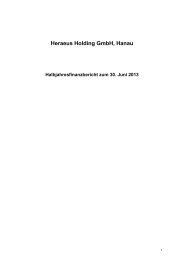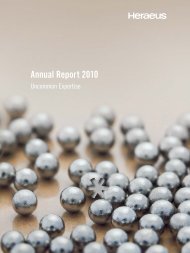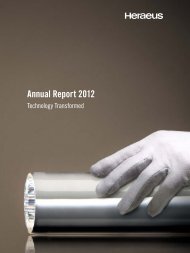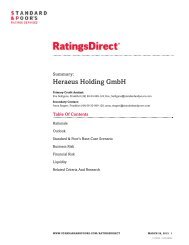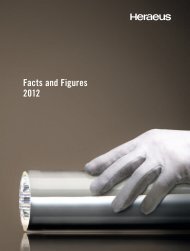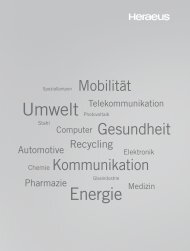english - About Heraeus
english - About Heraeus
english - About Heraeus
You also want an ePaper? Increase the reach of your titles
YUMPU automatically turns print PDFs into web optimized ePapers that Google loves.
14<br />
Application of new or amended standards and interpretations for the first time<br />
In 2012 no new or changed standards and interpretations were applied which had any<br />
impact on the Group.<br />
Statutory accounting requirements not yet adopted<br />
Several new standards and changes to standards and interpretations are applicable to<br />
financial years beginning later than January 1, 2012. These were not applied in these financial<br />
statements.<br />
Amendment to IAS 1 “Presentation of Financial Statements.” The amendment involves<br />
the presentation of other comprehensive income. The major change is that in the future<br />
companies will have to break down the components of other comprehensive income into<br />
those that will never be reclassified and those that will be reclassified. These changes<br />
do not relate to the content of other comprehensive income.<br />
Amendment to IAS 19 “Employee Benefits.” IAS 19 changes the definition of short-term<br />
benefits and other long-term benefits to employees in order to clarify the difference<br />
between the two. Eliminating the ability to choose how to record actuarial gains and losses<br />
for profit-sharing plans is not expected to affect the Group. The Group may, however,<br />
have to assess the effects of the change in the basis of valuation for expected earnings from<br />
plan assets. The amended version of IAS 19 will be applicable for the first time in the<br />
first reporting period of a financial year beginning on or after January 1, 2013, although<br />
earlier application is permitted.<br />
IFRS 9 “Financial Instruments” relates to the classification, recognition, and measurement<br />
of financial assets and liabilities. IFRS 9 was issued in November 2009 and October<br />
2010. This standard replaces the sections of IAS 39, “Financial Instruments: Recognition<br />
and Measurement,” which referred to the classification and valuation of financial instruments.<br />
In accordance with IFRS 9, financial assets are classified into two categories: those<br />
that are measured at fair value and those that are measured at amortized cost. This<br />
determination is made at initial recognition. The classification depends on how the Group<br />
has managed its financial instruments, as well as which contractually agreed cash flows<br />
are associated with the financial instruments. Most of the provisions of IAS 39 were retained<br />
for financial liabilities. The main change is that when exercising the measurement at<br />
fair value, the changes in value that result from corporate credit risk are recorded in other




